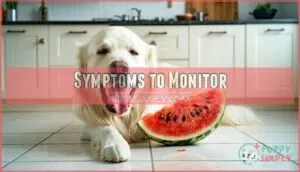This site is supported by our readers. We may earn a commission, at no cost to you, if you purchase through links.

While it’s not toxic, the tough green exterior poses serious risks.
Your pup can’t properly digest watermelon’s outside layer, potentially causing intestinal blockages or choking hazards.
The rind’s fibrous texture makes it difficult to break down, leading to stomach upset, vomiting, or dangerous obstructions requiring emergency vet care.
Stick to seedless watermelon flesh instead—it’s perfectly safe and packed with vitamins and hydration benefits.
Remove all seeds and rind completely before sharing this summer treat.
Understanding proper preparation methods and recognizing warning signs can keep your furry friend healthy while enjoying watermelon safely.
Table Of Contents
- Key Takeaways
- Watermelon Safety
- Can Dogs Eat Watermelon Outside
- Watermelon Rind Dangers
- Removing Seeds and Rind
- Feeding Watermelon Safely
- Watermelon Seed Risks
- Symptoms to Monitor
- Veterinary Advice
- Preventing Watermelon Risks
- Frequently Asked Questions (FAQs)
- Can dogs have the outer part of a watermelon?
- Can dogs eat the outside of a melon?
- Can dogs eat the green bit of a watermelon?
- Can puppies eat watermelon like adult dogs?
- How often can dogs eat watermelon weekly?
- Does watermelon affect dogs with kidney disease?
- Can diabetic dogs safely consume watermelon treats?
- What watermelon alternatives exist for sensitive dogs?
- Conclusion
Key Takeaways
- Don’t let your dog eat watermelon rind – The tough green exterior can’t be digested properly and poses serious choking hazards and intestinal blockage risks that may require emergency surgery.
- Remove all seeds and rind before feeding – Always prepare watermelon by completely removing the outer skin and any seeds to prevent digestive complications and ensure your dog’s safety.
- Stick to seedless flesh only – The juicy interior provides excellent hydration and vitamins A, B6, and C without the dangerous risks associated with the rind and seeds.
- Watch for warning signs – If your dog accidentally eats rind, monitor for vomiting, diarrhea, lethargy, or appetite loss and contact your vet immediately if symptoms appear.
Watermelon Safety
You might think watermelon’s a perfect summer treat for your dog, and you’re mostly right.
The juicy flesh provides excellent hydration and essential vitamins, but the outside parts tell a different story.
Nutritional Benefits
Watermelon’s nutritional benefits make it a healthy treat for dogs.
This fruit contains vitamins A, B6, and C, plus essential minerals like potassium.
With only 50 calories per cup, watermelon offers excellent nutritional value without excessive calories.
The high fiber content supports digestive health, while antioxidants combat aging and disease.
Hydration Importance
Your dog’s body is roughly 60% water, making proper hydration essential for healthy organ function and temperature regulation.
Just like humans, dogs need constant hydration to keep their organs functioning properly and their bodies cool.
Watermelon’s impressive 92% water content provides excellent summer hydration support, helping maintain electrolyte balance naturally.
This high water content makes watermelon for dogs an effective tool for preventing dehydration during hot weather, though watermelon rind dogs should never consume poses serious risks.
For variety, you can also offer dogs unsalted bone broth.
Can Dogs Eat Watermelon Outside
When you’re enjoying watermelon outdoors with your furry friend, you might wonder if they can safely eat the outside.
Unfortunately, the answer is no – dogs shouldn’t eat watermelon rind or skin.
While outdoor feeding can be fun, watermelon rind poses serious risks to your dog’s digestive system.
Here’s what you need to know about watermelon rind risks:
- Choking hazard – The tough texture can get stuck in your dog’s throat
- Intestinal blockage – Large pieces can cause dangerous obstructions
- Digestive upset – Even small amounts can trigger vomiting and diarrhea
- Emergency vet visits – Complications may require immediate medical attention
Some dogs experience watermelon allergies or breed sensitivity to certain foods.
Instead of risking the rind, stick to proper portion control with seedless flesh.
Consider treat alternatives like frozen watermelon cubes.
Always remove the skin before your dog can eat watermelon safely.
Watermelon Rind Dangers
While watermelon flesh is safe for dogs, the tough outer rind poses serious health risks that every pet owner should understand.
The fibrous rind can cause choking hazards and dangerous intestinal blockages that require emergency veterinary care.
Intestinal Blockage
About 80% of canine intestinal blockages occur in the small intestine, making rind impaction a serious concern.
Watermelon rind can turn summer treats into emergency vet visits fast.
Your dog’s digestive system can’t break down watermelon rind’s fibrous texture, creating a perfect storm for blockage symptoms like vomiting and lethargy.
This choking hazard often requires surgical intervention, especially in smaller breeds with narrower digestive tracts.
Blockages can lead to life-threatening complications if left untreated.
Preventative measures include removing all rind before feeding to prevent intestinal blockage and ensure your dog’s safety.
Gastrointestinal Distress
Even small amounts of watermelon rind can trigger digestive upset in your dog.
The tough, fibrous material causes bloating and gas as your pet’s system struggles with digestion. Watch for vomiting signs and diarrhea causes within hours of consumption.
Dogs with sensitive stomachs face higher risks of constipation relief issues and gastrointestinal problems from this indigestible material. Hence, it’s best to avoid watermelon rind consumption altogether.
Removing Seeds and Rind
Before you feed your dog watermelon, you need to remove all seeds and the tough outer rind completely.
These preparation steps prevent choking hazards and digestive problems that can send you straight to the vet’s office.
Safe Feeding Practices
You’ll want to follow proper portion control when offering watermelon to your furry friend. The dog digestive system handles this safe food best in small amounts through gradual introduction.
- Portion Control: Limit servings to one teacup for large dogs, half for smaller breeds
- Yogurt Pairing: Mix with plain, unsweetened yogurt for a creamy treat alternative
- Freezing Options: Create frozen cubes from pureed flesh for hot days
- Gradual Introduction: Start with tiny pieces to monitor your dog’s reaction to new foods
Consider exploring dog watermelon recipes for more creative serving ideas.
Preparation Methods
Once you’ve mastered safe feeding practices, proper preparation becomes your next step. Start by washing the watermelon thoroughly to remove pesticides and residue. Cut into small, manageable pieces—think 1-inch cubes that won’t overwhelm your pup.
It’s also important to note that tough rinds pose risks, so removing them is essential.
| Preparation Method | Serving Sizes | Best For |
|---|---|---|
| Fresh chunks | 2-6 pieces | Daily treats |
| Frozen cubes | 1-3 pieces | Hot weather |
| Pureed blend | 1-2 tablespoons | Sensitive stomachs |
Freezing options include pureeing seedless flesh and freezing in ice cube trays. For yogurt pairings, blend watermelon with plain, unsweetened yogurt—avoid anything with xylitol. Safe blending requires removing all watermelon rind and seeds first.
These preparation methods guarantee your dog enjoys this cool treat without digestive issues.
Feeding Watermelon Safely
Even though watermelon flesh is safe for dogs, you’ll want to stick to moderate portions and keep a close eye on your pet’s reaction.
Start with small amounts and watch for any signs of digestive upset, since too much can lead to stomach issues.
Moderation Importance
After removing watermelon rind and seeds, portion control becomes your best friend.
Watermelon should make up no more than 10% of your dog’s daily calorie intake to maintain a balanced diet.
- Start small: Give medium dogs one teacup, small breeds half that amount
- Limit treat frequency: Offer watermelon 2-3 times per week maximum
- Consider individual needs: Adjust portions based on your dog’s size and activity level
- Balance with regular food: Watermelon supplements, not replaces, complete pet nutrition
Monitoring Health
After giving your dog watermelon, keep a close eye on their behavior for the next 24 hours.
Watch for any signs of digestive upset, particularly if they accidentally consumed watermelon rind or seeds. Your vigilance can catch potential issues before they become serious health concerns.
| What to Watch | Normal Signs | Warning Signs |
|---|---|---|
| Digestive Changes | Regular bowel movements | Diarrhea, constipation, straining |
| Behavior Patterns | Normal energy, appetite | Lethargy, loss of appetite, whimpering |
| Physical Symptoms | Calm demeanor | Vomiting, excessive drooling, bloating |
Observe behavior changes like unusual restlessness or hiding. Check vomiting frequency and consistency. Monitor hydration levels by checking gum moisture. Note any gastrointestinal upset symptoms.
Keep your vet updated on concerning changes, especially regarding watermelon rind consumption and dog digestion issues that require immediate veterinary advice for dog health concerns.
Watermelon Seed Risks
You might wonder if those black seeds scattered throughout the watermelon flesh are safe for your dog to eat.
Watermelon seeds pose real risks including choking hazards and potential digestive blockages that require immediate attention.
Choking Hazards
Watermelon seeds create serious choking hazards for dogs, especially smaller breeds and puppies.
Rind size matters—large pieces increase swallowing difficulty. Breed susceptibility varies, with toy breeds facing higher risks. Puppy risks are elevated due to smaller airways.
Here’s what increases dog choking dangers:
- Black seeds pose greater blockage risks than white seeds
- Small breeds struggle more with seed removal from airways
- Puppies have narrower throats, making obstruction more likely
- Multiple seeds compound the choking hazard substantially
Always supervise feeding and remove all seeds before offering watermelon to prevent these emergencies.
Digestive Issues
Seeds aren’t easily digested and can irritate your dog’s gastrointestinal lining, causing uncomfortable digestive issues.
While watermelon rind edible concerns exist, seeds pose unique risks for gut bacteria disruption and intestinal blockage potential.
| Digestive Issue | Symptoms |
|---|---|
| Bloating and Gas | Abdominal distension, discomfort |
| Fiber Overload | Diarrhea, stomach cramping |
| Sensitive Stomachs | Vomiting, loss of appetite |
| Breed Differences | Smaller dogs show severe reactions |
These gastrointestinal health problems can escalate beyond simple upset stomachs, creating choking hazard situations requiring immediate veterinary attention.
Similarly, the hard texture of kiwi seeds’ outer shells may also lead to digestive issues.
Symptoms to Monitor
If your dog eats watermelon rind or seeds, watch for specific warning signs that signal trouble.
You’ll need to act quickly if you notice symptoms like vomiting, diarrhea, or unusual behavior changes.
Diarrhea and Vomiting
Stomach troubles can hit fast after a dog eats watermelon rind. Watch for diarrhea and vomiting—these digestive issues are your first red flags.
Both can lead to dehydration risks and electrolyte imbalance, especially if symptoms last. If vomiting or diarrhea is severe, don’t wait.
Veterinary intervention may be needed. Quick dietary adjustments can help, but always monitor symptom severity and watch for toxicity signs.
Lethargy and Whimpering
Beyond digestive symptoms, dogs experiencing discomfort from watermelon rind often show clear behavioral changes that signal they’re not feeling well.
When your dog’s energy levels drop noticeably and they start whimpering or seeking isolation, these pain indicators shouldn’t be ignored.
Key signs to watch for:
- Decreased energy levels – Your normally active dog may seem unusually tired or reluctant to play
- Whimpering or restlessness – Soft crying sounds or inability to get comfortable indicate abdominal pain
- Changes in sleep patterns – Difficulty settling down or excessive sleeping can signal distress from dog watermelon poisoning
Appetite loss often accompanies lethargy when dogs don’t feel right.
If your pup won’t touch their favorite treats after eating watermelon rind, this behavioral change combined with vomiting warrants immediate attention.
Remember, is watermelon rind toxic? While not poisonous, it can cause serious digestive issues requiring veterinary care.
Veterinary Advice
You should contact your veterinarian immediately if your dog eats watermelon rind or shows any concerning symptoms afterward.
Your vet can assess whether your pet needs emergency treatment or can be safely monitored at home.
Consultation Importance
Your pet’s health depends on getting professional dietary advice from your veterinarian.
When you’re concerned about watermelon consumption, vet communication becomes essential for pet safety.
A veterinary consultation provides personalized nutrition guidance based on your dog’s specific needs and breed considerations.
Report any symptoms clearly to help your vet assess potential risks and provide appropriate dog health recommendations for your pet owner concerns, ensuring pet safety and receiving professional dietary advice.
Emergency Situations
If your dog shows severe symptoms like persistent vomiting, appetite loss, or signs of intestinal blockage after rind ingestion or seed blockage, immediate action is required.
Don’t wait—this is a pet emergency. Veterinary intervention can prevent serious complications.
Symptom severity determines urgency, but when in doubt, contact your vet immediately. A choking hazard needs instant attention.
Preventing Watermelon Risks
You can protect your dog from watermelon dangers by taking simple prevention steps that keep them safe and healthy.
Smart storage and careful supervision will help you avoid emergency vet visits and keep treat time enjoyable for everyone.
Supervising Dogs
Active supervision proves essential when dogs interact with watermelon.
Constant vigilance helps you create a safe environment where responsible feeding becomes second nature.
- Immediate response: Watch for signs of distress or choking hazard during consumption
- Child supervision: Make certain kids understand watermelon rind dangers and proper feeding methods
- Dog safety monitoring: Check for intestinal blockage symptoms like vomiting or lethargy
Storing Watermelon Safely
Smart storage prevents dangerous watermelon rind exposure for dogs.
Keep whole watermelons in cool, dry locations away from curious paws.
Use proper cutting methods on clean surfaces, storing flesh in safe containers with tight lids.
Proper storage can be achieved with specialized food containers.
Refrigeration duration matters—consume within 3-5 days to prevent contamination.
| Storage Method | Dog Safety Level | Risk Prevention |
|---|---|---|
| Sealed containers in fridge | High | Blocks rind access |
| Countertop storage | Low | Easy dog reach |
| Covered outdoor areas | Medium | Weather protection |
| Basement/pantry storage | High | Secure location |
To ensure dog safety, it is crucial to follow these guidelines, as improper storage can lead to rind access and potentially harm dogs, emphasizing the importance of proper storage methods.
Frequently Asked Questions (FAQs)
Can dogs have the outer part of a watermelon?
Like a red flag signaling danger, watermelon rind spells trouble for your furry friend.
Don’t let your dog eat the tough outer skin—it’s hard to digest and can cause choking, intestinal blockages, or stomach upset.
Stick to seedless flesh only.
Can dogs eat the outside of a melon?
No, you shouldn’t give your dog melon rinds.
The tough, fibrous skin is hard to digest and can cause choking, intestinal blockages, or stomach upset.
Always remove the rind before offering melon flesh as a treat.
Can dogs eat the green bit of a watermelon?
Don’t let your dog eat watermelon’s green rind. It’s tough, hard to digest, and can cause choking, intestinal blockages, stomach pain, and diarrhea. Remove all rind before serving.
Can puppies eat watermelon like adult dogs?
You’re barking up the right tree asking about puppies.
Yes, puppies can eat watermelon like adult dogs, but they need smaller portions and careful supervision.
Remove seeds and rind completely, introduce slowly, and watch for digestive upset.
How often can dogs eat watermelon weekly?
You can safely give your dog watermelon 2-3 times per week.
Medium to large breeds can have one teacup serving, while small breeds should get half that amount or less each time.
Does watermelon affect dogs with kidney disease?
Watermelon can benefit dogs with kidney disease since it’s low in phosphorus and provides hydration.
However, you’ll need veterinary approval first—kidney issues require specific dietary management that varies by disease stage and severity, including careful consideration of hydration.
Can diabetic dogs safely consume watermelon treats?
Like walking through a minefield, diabetic dogs need extreme caution with watermelon’s natural sugars.
You should avoid giving watermelon treats to diabetic dogs, as even natural fruit sugars can spike blood glucose levels dangerously.
Always consult your veterinarian first.
What watermelon alternatives exist for sensitive dogs?
Consider cucumber, cantaloupe, or honeydew as gentler alternatives.
These fruits offer hydration and vitamins with lower sugar content.
Always remove seeds and rinds, serve in small portions, and consult your vet first.
Conclusion
Nearly 70% of dog emergency room visits during summer involve digestive blockages from inappropriate foods.
Remember, you shouldn’t let your dog eat the outside of a watermelon. The tough rind can’t be digested properly and may cause serious intestinal blockages requiring emergency surgery.
Always remove seeds and rind completely before offering this cool treat. When prepared correctly, watermelon flesh provides excellent hydration and vitamins for your furry friend during hot weather.
- https://maven.pet/all-about-pets/pet-care/dog-diet/can-dogs-eat-fruit/can-dogs-eat-watermelon-rind/
- https://articles.hepper.com/can-dogs-eat-watermelon-rind/
- https://pubmed.ncbi.nlm.nih.gov/19814770/
- https://www.petmd.com/dog/conditions/digestive/dog-intestinal-blockage-signs-and-what-to-do
- https://www.atlanticcoastvet.com/site/blog-long-island-vet/2022/05/30/intestinal-blockages-in-dogs-causes-and-treatment
















